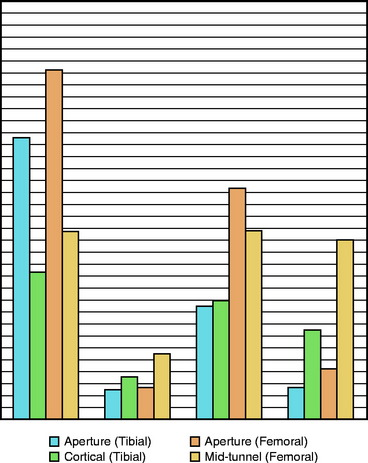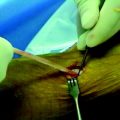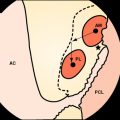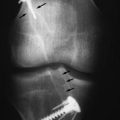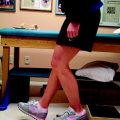Chapter 74 Tunnel Widening After Anterior Cruciate Ligament Reconstruction
Introduction
Tunnel widening after anterior cruciate ligament reconstruction (ACLR) has been noted for many years. Initially there were concerns that this widening would be progressive. However, it is now clear that tunnel widening only occurs in the first postoperative year1,2 and is not progressive after that period. A number of variables have been hypothesized to cause or contribute to tunnel widening. These include the following:
Specific Factors Associated With Increased Tunnel Widening
Hamstring Versus Bone–Patellar Tendon–Bone Graft
It has been hypothesized that HS grafts are associated with more tunnel widening than BPTB grafts. Tunnel widening has been found with the use of both grafts. Seven series specifically compared HS with BPTB. However, because fixation is different for the HS and BPTB grafts in all these series and because fixation type is one of the leading hypothetical causes of tunnel widening, the isolated effect of graft type is difficult to discern. Of these seven series,2–8 two report tunnel widening that is roughly equal for HS and BPTB and five report more tunnel widening with HS. These seven series are presented in bar graph form in Fig. 74-1.
Allograft Versus Autograft
Two clinical series9,10 have shown increased tunnel widening in allografts versus autografts. In addition, a recent sheep study by Weiler showed increased tunnel widening in allografts at all time periods measured, beginning at 6 weeks and ending at 1 year.11 Possible causes include an increased immunologic response to the graft or the presence of chemical residua in the grafts from processing, cleansing, cryoprotectant, radioprotectant, or the like.
Effects of Fixation Location
It has been suggested that the increased incidence of tunnel widening in HS ACLR may be due to fixation. Specifically, a “windshield wiper” effect resulting in greater tunnel widening when the fixation is further from the joint, as is more often the case with HS than BPTB graft fixation techniques, has been hypothesized. It is theorized that with knee motion, the pressure of the graft on the tunnel wall will vary more with cortical or mid-tunnel (cross-pin) than aperture fixation, producing attrition of the tunnel wall. A review of the literature in this regard does not show a consistent effect of the location of the fixation.12–17 The four studies comparing aperture to cortical or cross-pin fixation are presented in Fig. 74-2.
Aggressive Versus Conservative Rehabilitation
The effect of motion and rehabilitation has been addressed in three studies in which different postoperative protocols were used by the same surgeon after ACLR.18–20 The study by Hantes et al18 showed significantly decreased tunnel widening when motion was restricted after ACLR. The study by Yu and Paessler20 also showed significantly decreased tunnel widening when motion, weight-bearing, and strengthening activities were all restricted. The study by Murty et al19 showed the opposite: significantly increased tunnel widening when motion was restricted after ACLR.
Synovial Fluid Infiltration
Synovial fluid in the bone tunnels has been hypothesized as a possible cause of tunnel widening without a specific mechanism; it has been suggested that “enzymes” in synovial fluid may in some fashion break down bone. It has been hypothesized that applying an apertural seal may prevent this breakdown. In one of the only studies to look at this issue,21 no tunnel widening was found with HS grafts despite the presence of synovial fluid in bone tunnels.
Adverse Effects
Effects on Revision Surgery
The only indirect adverse consequence of tunnel widening is its potential effect on revision of failed ACLRs. Tunnel widening adversely affects revision surgery, depending partially on the revision technique used. A detailed description is presented in Chapter 57.
Strategies to Decrease Tunnel Widening
Until the causes of tunnel widening are better understood, strategies to diminish it will be speculative. Many believe that the use of either bone graft22 or osteoconductive interference screws such as the Milagro (Mitek, Raynham, MA) or Collaxo (Smith & Nephew, Andover, MA) will be likely to decrease tunnel widening. However, although anecdotal corroborative evidence exists, we are not aware of any published report that validates this hypothesis.
Conclusions
1 Lajtai G, Noszian I, Humer K, et al. Serial magnetic resonance imaging evaluation of operative site after fixation of patellar tendon graft with bioabsorbable interference screws in anterior cruciate ligament reconstruction. Arthroscopy. 1999;15:709-718.
2 Clatworthy MG, Annear P, Buelow J-U, et al. Tunnel widening in anterior cruciate ligament reconstruction: a prospective evaluation of hamstring and patella tendon grafts. Knee Surg Sports Traumatol Arthrosc. 1999;7:138-145.
3 Aglietti P, Giron F, Buzzi F, et al. Anterior cruciate ligament reconstruction: bone-patellar tendon-bone compared with double semitendinosus and gracilis tendon grafts. J Bone Joint Surg. 2004;86A:2143-2155.
4 Hersekli MA, Akpinar S, Ozalay M, et al. Tunnel enlargement after arthroscopic anterior cruciate ligament reconstruction: comparison of bone-patellar tendon-bone and hamstring autografts. Adv Ther. 2004;21:123-131.
5 L’Insalata JC, Klatt B, Fu FH, et al. Tunnel expansion following anterior cruciate ligament reconstruction: a comparison of hamstring and patellar tendon autografts. Knee Surg Sports Traumatol Arthrosc. 1997;5:234-238.
6 Webster KE, Feller JA, Hameister KA. Bone tunnel enlargement following anterior cruciate ligament reconstruction: a randomized comparison of hamstring and patellar tendon grafts with 2-year follow-up. Knee Surg Sports Traumatol Arthrosc. 2001;9:86-91.
7 Zysk SP, Fraunberger P, Veihelmann A, et al. Tunnel enlargement and changes in synovial fluid cytokine profile following anterior cruciate ligament reconstruction with patellar tendon and hamstring tendon autografts. Knee Surg Sports Traumatol Arthrosc. 2004;12:98-103.
8 Harilainen A, Linko E, Sandelin J. Randomized prospective study of ACL reconstruction with interference screw fixation in patellar tendon autografts versus femoral metal plate suspension and tibial post fixation in hamstring tendon autografts: 5-year clinical and radiological follow-up results. Knee Surg Sports Traumatol Arthrosc. 2006;14:517.
9 Fahey M, Indelicato PA. Bone tunnel enlargement after anterior cruciate ligament replacement. Am J Sports Med. 1994;22:410-414.
10 Zijl JAC, Kleipool AEB, Willems WJ. Comparison of tibial tunnel enlargement after anterior cruciate ligament reconstruction using patellar tendon autograft or allograft. Am J Sports Med. 2000;28:547-551.
11 Scheffler S, Unterhauser F, Keil J, et al. Comparison of tendon-to-bone healing after soft-tissue autograft and allograft ACL reconstruction in a sheep model. Presented at the 2006 meeting of the European Society of Sports Traumatology, Knee Surgery, and Arthroscopy, Innsbruck, Austria, May, 2006. 2006.
12 Buelow J-U, Siebold R, Ellermann A. A prospective evaluation of tunnel enlargement in anterior cruciate ligament reconstruction with hamstrings: extracortical versus anatomical fixation. Knee Surg Sports Traumatol Arthrosc. 2002;10:80-85.
13 Harilainen A, Sandelin J, Jansson KA. Cross-pin femoral fixation versus metal interference screw fixation in anterior cruciate ligament reconstruction with hamstring tendons: results of a controlled prospective randomized study with 2-year follow-up. Arthroscopy. 2005;21:25-33.
14 Ma CB, Francis K, Towers J, et al. Hamstring anterior cruciate ligament reconstruction: a comparison of bioabsorbable interference screw and endobutton-post fixation. Arthroscopy. 2004;20:122-128.
15 Sakai H, Yajima H, Hiraoka H, et al. The influence of tibial fixation on tunnel enlargement after hamstring anterior cruciate ligament reconstruction. Knee Surg Sports Traumatol Arthrosc. 2004;12:364-370.
16 Simonian PT, Erickson MS, Larson RV, et al. Tunnel expansion after hamstring anterior cruciate ligament reconstruction with 1-incision Endobutton femoral fixation. Arthroscopy. 2000;16:707-714.
17 Simonian PT, Monson JT, Larson RV. Biodegradable interference screw augmentation reduces tunnel expansion after ACL reconstruction. Am J Knee Surg. 2001;14:104-108.
18 Hantes ME, Mastrokalos DS, Yu J, et al. The effect of early motion on tibial tunnel widening after anterior cruciate ligament replacement using hamstring tendon grafts. Arthroscopy. 2004;20:572-580.
19 Murty AH, Zebdeh MY, Ireland J. Tibial tunnel enlargement following anterior cruciate reconstruction: does post-operative immobilization make a difference? Knee. 2001;8:39-43.
20 Yu JK, Paessler HH. Relationship between tunnel widening and different rehabilitation procedures after anterior cruciate ligament reconstruction with quadrupled hamstring tendons. Chin Med J. 2005;118:320-326.
21 Sanders TG, Tall MA, Mulloy JP, Lesis HT. Fluid collections in the osseous tunnel during the first year after anterior cruciate ligament repair using an autologous hamstring graft: Natural history and clinical correlation. J Comput Assist Tomogr. 2002;426:617-621.
22 Howell SM, Roos P, Hull ML. Compaction of a bone dowel in the tibial tunnel improves the fixation stiffness of a soft tissue anterior cruciate ligament graft: an in vitro study in a calf tibia. Am J Sports Med. 2005;33:719-725.


